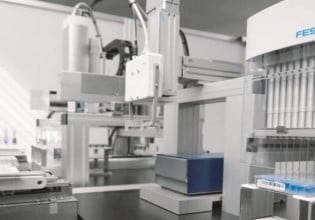Types of Process Manufacturing Equipment
During process manufacturing, raw materials are mixed together to create a product. This process includes many stages, and thus, copious types of equipment.
The equipment used in process manufacturing relies heavily on the particular product and industry of interest. The iron and steel industry will require different equipment than the food, petroleum, mineral, or water treatment industries.
It is important to note that process manufacturing, while not counting discrete products, still has many measures to determine productivity, throughput, and efficiency. Crude oil production can be thought of as a process manufacturing industry, and even though the product is continuously flowing, it is quantified by the number of barrels.
Also, because process manufacturing often involves creating volumes of material from raw products, quality control and statistical tools become extremely important. Therefore, most process manufacturing facilities either have an onsite lab for quality assurance testing or partner with a laboratory that conducts testing.
Process Manufacturing Processes
In process manufacturing, products go through several stages: materials handling, refining, packaging and shipping, and finally, quality control. Let’s look into the types of equipment used at each stage.
Materials Handling
Regardless of the process manufacturing facility, the initial raw material collection and processing is the first step in the manufacturing process. At a mine or a wellhead, this step involves extracting materials from the ground. For materials processing, such as metals, paper, lumber, and so on, this is handling the initial materials as they arrive by truck or rail.

Figure 1. A molten metal rail car transfers small quantities of metal from a charging furnace to other parts of the foundry. Image used courtesy of James St. John
For the mining industry, materials handling equipment includes shovels (bucket cranes), haul trucks, conveyor lines, drilling rigs, air handling equipment for underground mines, and blasting equipment. For the metals industry, this includes cranes with electromagnets, charging furnaces, water circulator pumps for water cooling systems, and so on. In the chemical industry, materials handling equipment includes any sort of batching, mixing, injection, and other equipment that combines raw material streams. In agricultural production facilities, equipment includes combine harvesters that separate the grain from biomass not used for human consumption (such as corn stalks), automated reapers, tree-shakers, grain dryers, mixers, and other such equipment.
Important controls at this stage are methods of removing foreign materials and physically mixing the initial materials. For example, occasionally, a small pebble will become mixed in with grain and need to be removed. Mobile Geiger counters are installed at steel mills to prevent radioactive materials (particularly from medical waste) from contaminating heat. In the future, automation will continue to improve detection and removal methods for foreign objects.
Refining
The refining steps finalize the chemistry and physical properties of the product. Raw materials can scarcely be called “raw” materials anymore, but they are not finished. Paint manufacturers may have the base, but not the tint, and steel may be in the molten form, but not yet converted into useful shapes.
Once the material is more-or-less homogenous, the refining process equipment takes over. This can be anything from ball mills in a copper mine, which break up the ore into fine powder for chemical processing, to a hydrocarbon cracker in an oil refinery, which separates the various petroleum product streams (oil, gasoline, kerosene, diesel, asphalt, wax, etc.).
Processing equipment in the refining steps includes methods of coating, heat treating, purifying, separating, reacting, or forming. For the chemical industry, this step often involves separating desirable chemicals from others (crystallizers, settlers, evaporators, distillation columns, crackers, extractors), refiners, or reactors. This may include heat treating ovens, carburizing ovens, rolling mills, and continuous machining equipment (for deburring and final shaping) in metallurgy. The food and agriculture industry uses pasteurizing equipment, fermenters, and other such sterile hardware for ensuring the product is clean and free of bacteria and fungi.
Packaging and Shipping
Packaging is often where the lines between process manufacturing and discrete manufacturing are blurred. For the most part, customers buy a quantity of an item, so the continuous stream must be divided into parts to be shipped to the customer. This could be in the form of canning soup, cutting rolled steel I-beams to transportable lengths, producing copper cathodes from the electrowinning process, or some other such operation.

Figure 2. Copper cathodes are used to plate copper from a continuous solution. The coated cathodes are a discrete product made from a continuous process. Image used courtesy of Xstrata Technology
Packaging operations are heavily interleaved with the quality control operations, because it is not economical to package bad products. Each industry has separate requirements for this step; for instance, the agricultural industry has strict requirements for documenting, packaging, and inspecting a product.
Automation has benefitted this step immensely, as some of the inspection and packaging objects can be performed automatically on the same line. This reduces the chances of contamination or damage due to excessive handling.
For example, an automated ketchup line may sterilize bottles with steam, check the bottles for cracks with polarized light and machine vision, fill the bottles, screw the cap tight, then check the seals—all on one or two pieces of equipment. This is much more efficient than performing separate operations in different parts of the factory. It is also much safer than steam cleaning the bottles, handling them, and potentially contaminating them.
Quality Control
One of the common dilemmas during budget crunches is whether to perform testing in-house or send it to an external lab. Testing must be performed and traceable in case of a process excursion, when affected lots can be located and replaced.
Even with mined products, such as coal, there is some record for traceability. For example, coal-fired power plants routinely segregate and then blend coal from different sources to optimize heating. How they are blended depends on the chemical analysis of each lot.
Should a facility want to keep testing in-house, testing equipment can range from spectroscopy tools (spark, UV-visible light, etc.) and gas chromatography (GC) equipment for chemical analysis, to scanning electron microscopes (SEM) and optical microscopes for ensuring proper microstructure in metals. It even includes mechanical testing apparati, such as tensile test machines, hardness testers, and fatigue testers.
This article barely touches on the myriad of process manufacturing equipment that is available. With increased instrumentation capabilities, process manufacturing equipment can be expected to be more connected to other devices, more capable of making process control decisions, more likely to self-diagnose, and ultimately, more user-friendly in the future.






